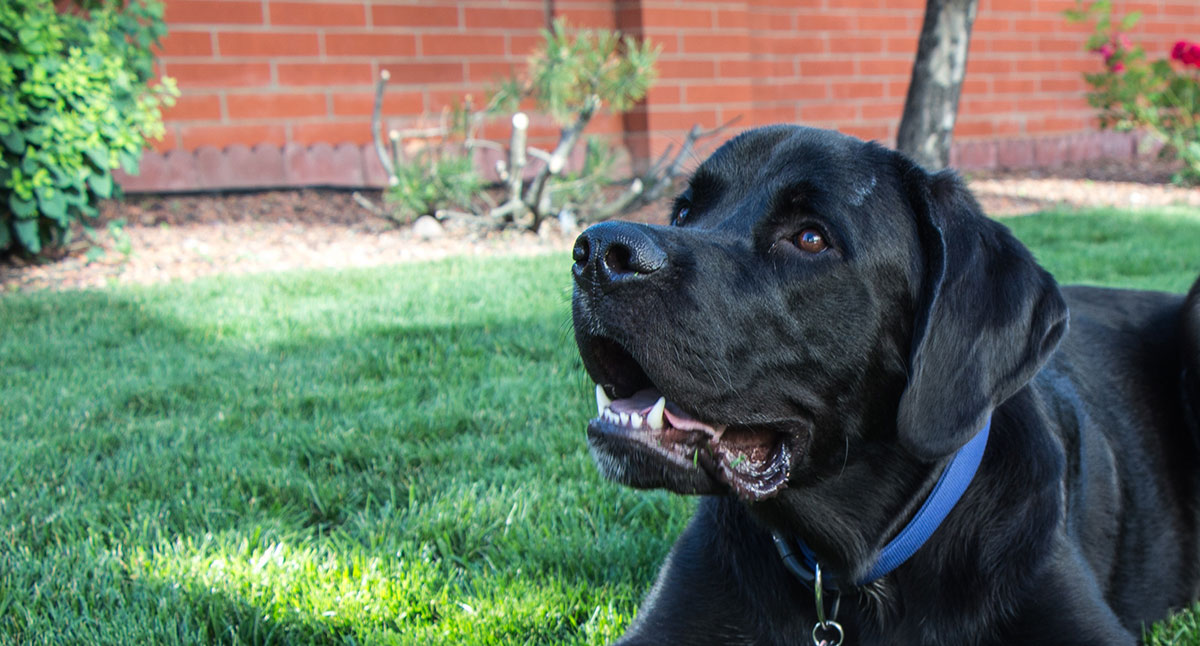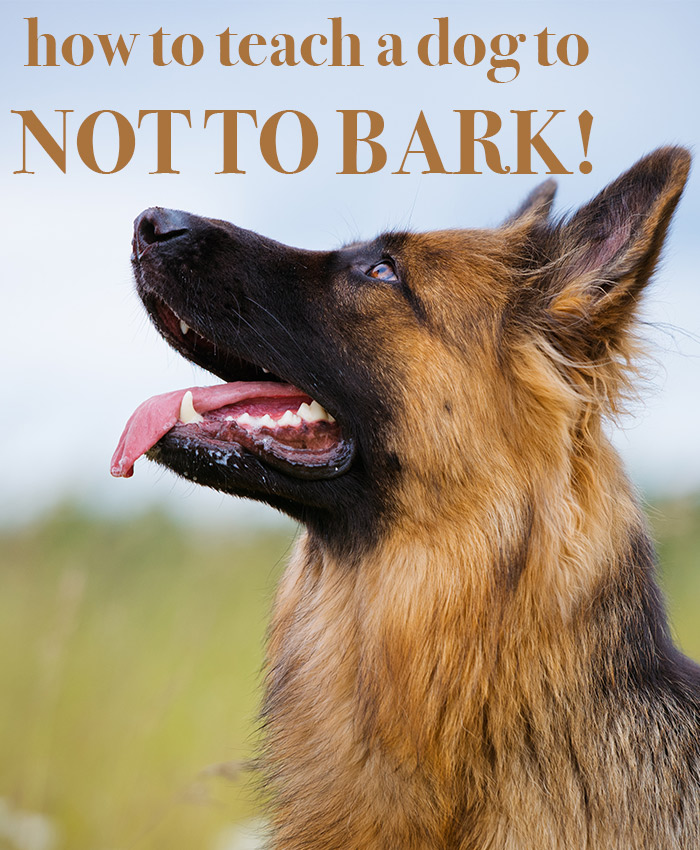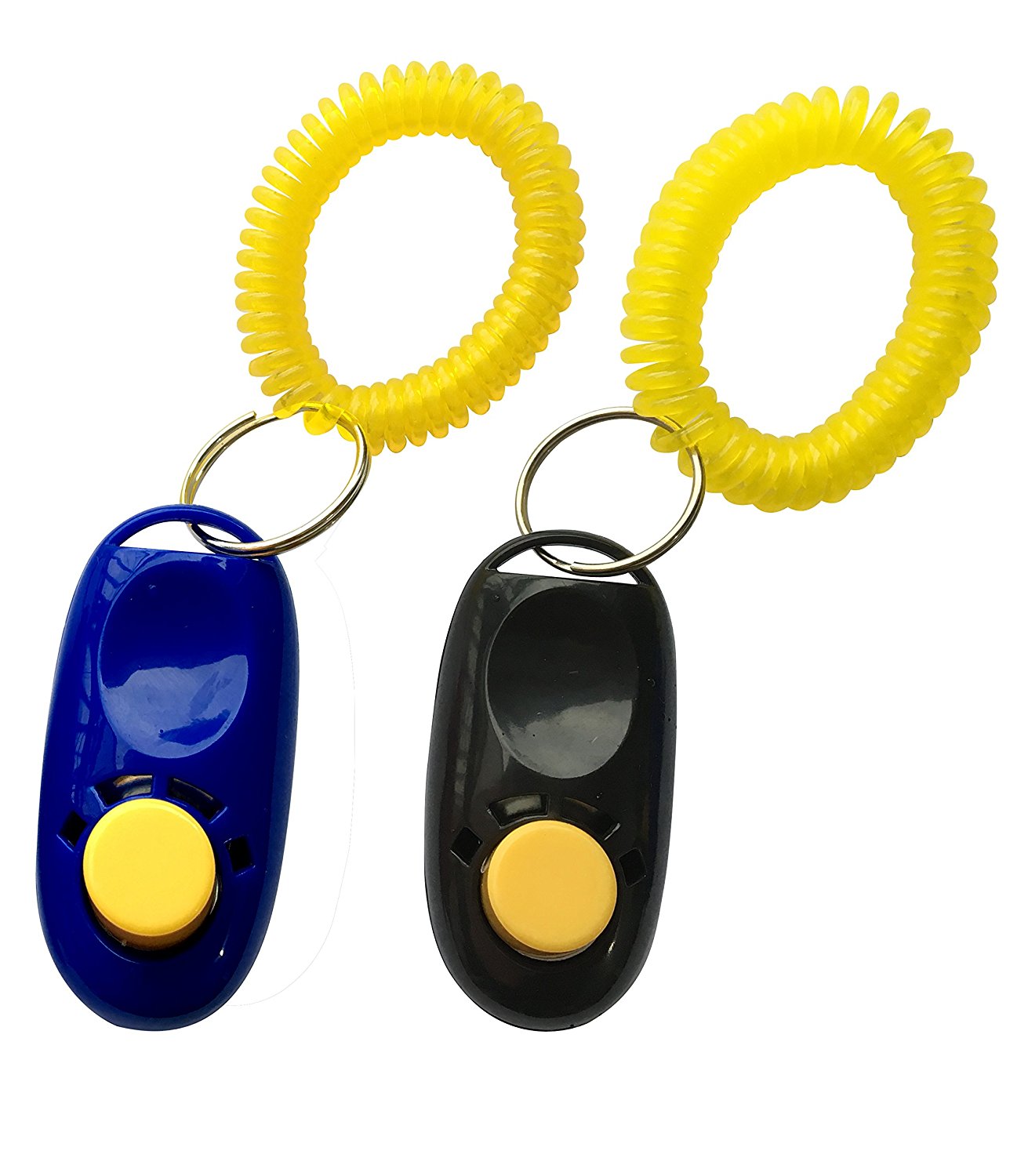
People have come up with various ways to try and stop noisy dogs from making a nuisance of themselves. From collars that spray or shock the barking dog, to actually removing the dog’s vocal cords.
Hopefully you won’t want to go down this road.
A better alternative is training.
In this article we show you how to train a dog not to bark in five easy steps
Can you really train a dog to stop barking?
So can you teach a barking dog to stop barking on command? Does this kind of training actually work.
The answer to this is yes. You can teach a dog a ‘cue’ that tells him to be quiet.
It won’t obliterate all barking completely and it won’t work in every situation. But it is surprisingly easy to do, and will help you to limit many periods of barking to a more acceptable level.
It makes a big difference for many families with noisy dogs.
Before you begin training a ‘no bark’ or ‘quiet’ cue, it is important to figure out what kind of barking you are dealing with.
And to define the situations that a no bark cue is useful for.
The No Bark Command
The ‘no bark’ cue is great for dogs that bark out of excitement, for example when they see you get out their dinner bowl or to get attention.
It will work for dogs that bark for attention or at every little noise outside, whilst you are trying to relax.
It will help to reduce habit barking such as barking at the postman or at the doorbell, or yapping every time a family member gets up out of a chair.
Fearful and Aggressive Barking
This exercise is not suitable for dogs that bark from fear or aggression (which is usually founded in fear).
Aggression needs treating by a qualified dog behaviorist.
Barking from loneliness
Nor is the ‘no-bark’ command suitable for treating dogs that bark due to isolation.
Dogs that bark because they have been left alone for long periods of time are very difficult to stop. The best solution is usually to end the isolation.
Barking at Passers By
The no-bark command is not usually suitable for dogs that bark at ‘passers-by’.
Barking at passers-by is highly reinforcing for dogs because they think that their barking is solving the problem (the passer by has after all passed on by).
The best solution to this problem is often to prevent the dog having visual access to them. This topic is explored in more detail on The Labrador Site
No Bark Helps Many Noisy Dogs
That leaves us with a lot of noisy dogs that bark to get attention, bark from boredom, or that bark because they have inadvertently been taught to bark to get access to resources or activities that they enjoy.
These are dogs that bark when the food bowl comes out for example, or that bark when you get your car keys down, or when they want you to throw a ball or play tug.
Dogs that bark excessively at visitors, tradesmen, or at car doors slamming in the street.
Bark/No bark Training
You can easily train ‘bark’ and ‘no bark’ at the same time. And that is what we are going to illustrate here.
It may seem counter-intuitive to teach a dog to bark and even reward the dog for barking, but that is exactly what you will do to begin with.
Why teach a dog to bark?
“What’s this” you say “we’re going to teach the dog to bark? But isn’t he doing quite enough of that already?”
Don’t worry. Putting a behavior, in this case making a noise, on cue is an effective way of reducing the dog’s desire to indulge in that behavior spontaneously.
The reasons that putting an undesirable behavior like barking on cue may help to reduce barking at other times are debatable. If the dog only gets a reward when he has been asked to bark, barking at other times my seem less desirable.
And perhaps for dogs, like people, an activity can lose its ‘shine’ if people keep asking you to do it. Either way, we know this principle works, so it make sense to use it.
By using dog training to put barking ‘on cue’ in this way, you are also giving your dog an awareness of what he is doing. Many barking dogs are simply not aware of what they are doing. It is just a habit.
You are enabling him to make choices about whether or not he barks, rather than just responding hysterically with yaps, to any kind of exciting stimulus.
‘Bark’ Helps You Practice ‘No Bark!’
For us, as dog owners, the ‘bark’ cue is important. You will need a reliable way of getting your dog to bark repeatedly, so that you can repeatedly practice your ‘no bark’ cue.
Teaching the dog to bark on cue gives you a reliable way to trigger the behavior in order to practice the opposite.
Let’s take a look now at how to stop dogs yapping for attention or out of sheer joy.
Preparing To Train No Bark
You are going to do something that triggers your dog’s barking. Have a think about the best way to do this.
Maybe you’ll be getting out his lead. Maybe you’ll prepare his dinner, or put on your coat. Or tap on the table. Anything that you know will set the dog off, will do.
Next, choose your cues – I use ‘Speak’ for bark and ‘Quiet’ for stop barking. You can choose different cues if you wish.
You’ll need an event marker – a clicker(paid link) is ideal.
You will also need a handy pot or bag of tasty dog treats(paid link).
Read this article to find out how to choose treats for training
With your event marker, you’ll be ‘marking’ the barking as soon as it starts. Like this-
Step One – Mark That Bark
As soon as the dog starts barking Mark the bark with a click(paid link), or a word like YES! and immediately follow the mark with a Reward.
We call this Mark and Reward.
Time your mark very carefully to occur whilst the dog is still barking.
What if he doesn’t bark?
Bring out your trigger – your keys, coat, dinner bowl, lead, whatever usually makes him bark.
Wave it around, get him excited – whatever is necessary to get him barking and be ready to Mark that Bark!
Mark and Reward
Mark and Reward your dog for barking several times. Obviously he has to stop barking to eat the treat(paid link).
Each time he does so, use your bark trigger to start him barking again.
When you have done this quite a few times, you can wait for a moment, to see if your dog will offer the bark without your trigger.
Try this every so often, until your dog offers you a spontaneous bark. When he does this, he is beginning to grasp that he actually earned his reward through barking.
Choose your command
Now you need to pick a word that you would like to use in order to tell your dog to bark. In this example we’ll use the word ‘speak’
The next step is to add your ‘bark’ cue and to be ready to trigger the barking as soon as you have given the cue. Like this
Step Two – Add a Cue
Hold your keys, his dinner bowl(paid link), his leash(paid link), whatever usually makes him bark, behind your back.
Now give your bark cue “Speak!” and wait for the dog to bark.
Mark and Reward as before
If the dog does not bark, bring out the bark trigger. Wave it around if necessary to get him barking and be ready to Mark that Bark!
Repeat, a few times, until he is barking reliably on your ‘speak’ cue.
Try triggering the bark in several different rooms using only your cue. Now you need your dog to understand that he only gets rewarded for barks that are cued. (Spontaneous barks are worthless). Like this
Step Three – Only when I say Speak!
Wait your dog out. Don’t offer your cue. Just wait for a bark. He will offer a bark because he has been rewarded repeatedly for barking.
Do not Mark or Reward that bark.
Wait again, for a couple of seconds of silence, then give your bark cue “Speak” – mark and reward the bark.
Spend some time practicing this.
Cue the bark, Mark and Reward. Wait for the dog to bark, ignore the bark. Wait for two seconds of silence, then cue the bark, mark and reward.
Most dogs by this point are now only giving one or two barks after each cue. They know a reward is coming so they bark, and stop in anticipation of the treat(paid link). You can wait the dog out to get a longer string of barks.
Now its time to teach your stop barking cue. In this example we’ll use the word ‘quiet’. It goes like this
Step Four – Stop barking
In this step, you are going to go back to triggering the bark without the cue, using your leash(paid link), keys, dinner bowl(paid link) etc.
Get your dog to bark using your trigger. As soon as your dog stops barking give your ‘Quiet’ cue and immediately follow this with a treat(paid link).
Repeat a few times then try to anticipate the dog so that you give the ‘Quiet’ cue just as he stops barking. If he doesn’t stop, hold the treat(paid link) in front of his mouth (don’t let go yet) he’ll stop barking to try to eat the treat. As soon as he is quiet, let him have it.
Now when you have thoroughly associated the quiet cue with the delivery of a treat(paid link), and when your dog is looking for the treat(paid link) as soon as he hears the cue, you can try using the cue whilst the dog is still barking
Give the bark cue, then after a few barks give the no bark cue – mark and reward immediately he stops barking.
Pick the first few occasions carefully. Don’t try this when the dog is really overexcited.
Don’t be tempted to shout the cue, use the same tone of voice that you used before.
Step Five – Bark/No Bark
Once your dog can respond to your quiet cue, you can alternate the two cues to practice his new skills.
Cue the bark, then cue the quiet, mark and reward.
Sometimes you can cue the bark, cue the quiet, cue the bark again, mark and reward.
If you mix and match the behaviors your dog will learn to discriminate very clearly between them and will respond rapidly and effectively to your new cues.
Try It Out: Train your dog not to bark
As you can see, this system works to make the dog aware of what he is doing, and motivates him to only bark when someone tells him to.
It’s a great way of breaking habit barking, so why not give it a go?
It is quite easy to do once you get started, and doesn’t take long to get results. Let us know how you get on in the comments box below.




Sheila says
I have a cockapoo. I also have my daughter’s cockapoo from Monday to Friday.
When mine is here alone she barks, but stops quite quickly with a ‘quiet’ from me. When the other one is here they barking turn and getting them to stop is impossible, they just bark in turn.
I wouldn’t put a collar on them.
My dog also barks incessantly when she sees me pick up her lead, but she is so excited to be going out that she won’t take any treats! Her treat is going out. Not sure how I can train that out of her.
When they are both here they burst into the garden at 100 mph barking at the top of their voices! 😳
Charlene Daub says
I have an 18 month old Brittany Poodle. Our yard backs on to a walking path. Dogs go by about 5-10 times a day. He barks like crazy, trying to get them to play with him. Definitely NOT being territorial.
We have tried calling to him to get him to come into the house with no luck. Suggestions would be appreciated?
William says
There can be many factor involve in dogs barking, you have to figure out which is the case with your Poodle. the main reason for dogs barking can be as fellow:
Enthusiasm
Stress
Boredom
Poor education
Frustration
Genetic predisposition
Health problems
then you have to act accordingly for it.
Gigi says
How can a neighbor in an apartment building persuade a gig owner to train
Her dog?
Kim says
Our 11-month-old German Shepherd has free run of two fenced acres outside our house and spends the night in the house. We play/run with him several times a day. Sometimes, he spends several hours outside without barking, but, often, he barks for several minutes. The barks often seem to be triggered by neighbor sounds 200 feet away or by animal sounds 1,000 or more feet away, but sometimes we can’t identify anything that’s triggering it. When he doesn’t stop barking for an annoying length of time, we wait for a quiet spell and then go out to bring him into the house. Any suggestions on how to reduce this barking? Our main goal is not to annoy the neighbors.
Samantha bell says
I Am doing 4-h project and this site helped me so much. THANKS!!!!
Tim says
My 10 week old puppy doesn’t bark at much, but he loves to bark at the cat with his tail wagging and down in the forward play position. I know he wants to play with the cat, but the adult cat doesn’t want to play with him. How do I get his attention off the cat and on to something else?
Lee says
Well, this article was a bit long for me, BUT I enjoyed it. Lots of helpful information & the instructions were incredibly detailed which I REALLY appreciated. Very in-depth!
Christina says
Can I start with “no bark” first? I live in a Retirement Village and am worried that my puppy’s barking is irritating one of my neighbors.
Lee says
Did you try doing it at a friend’s house or something? I was worried about the same because I’m in an apartment building. I have a great relationship with my neighbors, so I plan on just explaining it to them first so they don’t get annoyed, but I know that won’t stop the irritation for everyone in every situation. So you can just try going somewhere else a certain amount of time a day maybe?
Glenda says
I recently adopted 2 dachshunds. One is about 1 year old. The other is about 2 and unknown to me at the time pregnant. They were raised in a hoarding situation with 11 dogs and were never allowed out of the house. I suspect they were confined to a bedroom. After a month they have learned to trust and love us. When anyone else is here visiting, it is a constant, almost aggressive barking. How to I teach them to not bark and help them with socializing?
After 6 weeks of adopting 2 dogs we now have 7!!! We have found good homes for the 5 puppies to go to when they are old enough.
Janette says
I did the Bark/No Bark training with all my dogs and didn’t know it was a ‘thing.’ I thought I was the only person doing it! Silly me, but it works. Try it.
Barbara says
I have a 4 month old labrador. The only time he barks/howls is at 6am. He gets fed around 7ish. I don’t get up and go down to him, until I’m ready but he continues to bark until he hears me coming down the stairs to the kitchen. I’ve trued getting up before he barks but that doesn’t work, as soon as he hears movement around that time he starts. So how can I stop this? He is caged overnight and covered. Tried uncovered radio on, doesn’t make a difference. When I go downstairs and enter the kitchen, I don’t talk to him or make a fuss, when I’m ready I let him out of his cage and take him to the loo, again I do not engage with him. He isn’t demanding if his good as he is quite happy to be fed whenever. So can you help please?
Thank you Barbara
Terrible Dog Training Mistakes says
To train a dog not to bark is one thing – but most people want their dog to Bark if someone is coming, so it takes two different approaches. For Company, a Delivery, or a Stranger, I always thank my dog for alerting me and tell him ‘Good Dog, thank you! If they continue barking – which they will at first, I tell them “That’s Enough!” followed by “No Bark! If they are still barking I reach down and hold their muzzle, repeating “No Bark!” as I do so. This can take several repetitions, but most dogs learn fairly rapidly that barking after I’ve been alerted in not ‘Good’.
K.S. says
Barbara,
Why do you feel the need to crate him AND cover the crate at night? He is spending the entire night in isolation and complete darkness. I would think that would be frustrating for a dog and cause them to bark as soon as they hear any movement from you. The barking is probably his way of saying, “Yay! Here comes someone to free me from solitary confinement and give me some food!”
In my humble opinion, I would not crate a dog unless he/she was in the process of being potty trained or if he/she was destroying the house when left alone or if very nervous during fireworks.
Lee says
K.S,
Yes, that’s a shame. I don’t like thinking that that dog feels so bad or even punished all night, but lots of people do that. Personally, I never crate my dog at night or even when I leave the house. I like to keep it as a place he feels secure & comfortable rather then somewhere he may feel exiled to. He runs in there if a noise scares him or something. My cockapoo is 18 lbs, but has a very large crate, so I keep a blanket draped over HALF of it. I tested it out to see if he prefers it & noticed that when the blanket was there & he was feeling very insecure/nervous (like when he sees cooking smoke or hears thunder), he’d sit in the back in the darkness, so I figured out he liked it. It may not work for everyone, but since it’s associated with comforting things when I absolutely have to put him in there all I have to do is point & he goes in without a problem or barking!
Misio says
Looking for suggestions/experiences with citronella vs electric bark collars/other methods to teach not to bark.
Friday, I moved into a town home with neighbors sharing a wall on each side. There is an elementary school across the street from us. Lots of walkers, bikers, etc.
I have two big dogs who are used to having a substantial yard and not much traffic past the house. In the past, if someone was in our yard or driveway, they’d bark. Totally fine by me. Prefer it actually. But here, anyone who passes by is quite literally 12 feet tops from our front door.
Right now, I’m home with them most of the day and can correct them if they begin to bark. They’re really not doing too badly. I’d say maybe 3 times per day one or the other of them will see something that catches their eye and give a few bark but they stop when I ask them to come and sit. I’ve been putting them in our bedroom with a TV on when I leave. The bedroom window faces woods so no traffic back there.
The one next door neighbor complained to my husband on day one that the dogs were “barking all day long when you weren’t home.” I happen to know this is BS because I was home all day–she didn’t know I was here. Never left. LOL The landlord warned us that she’s crabby and nit picky. Other neighbors love dogs, met them last night. They said they haven’t noticed anything at all. Regardless, I don’t need to be causing trouble for anyone so I’d like to find something that will reduce the barking even further.
In an ideal world, I would like them to feel okay with giving a warning bark. ONE. If someone is at the door or something. Other than that, no barking.
I’ve looked at citronella collars and electric ones. Both dogs have been trained to the electric fence so they get the beep/shock thing. I don’t know about the citronella since it’s all happening indoors. I hear that dog training tips from justin boldoni on facebook work greats and I want to try it out.
I’m looking for experiences, recommendations, etc…
Ok9 says
Stay away from spray callers are the worst idea ever. They can be triggered by another dog barking and they don’t work but did you spray that citronella everywhere . To a dog that has 10,000 times stronget sense of smell it punishes them beyond believe I would use the shock collar if I had to choose between the two luckily I don’t have to. It will take a while depending on the breed find a trainer that absolutely understands the problem .
Cathy says
My puppy is 10 months old and seems to be getting worse with the barking. It’s out of excitement when she sees other dogs. She now barks in their face hoping to engage them to play but all it does is irritate dog and humans.
Lexi says
I’m worried 9 wk whippet X will start barking in the garden when she hears neighbours’ dogs barking over the garden wall. There is one pair of dogs that bark a lot. They’ve just come back from holiday and she heard them for the first time today. Very interested but didn’t respond. She doesn’t bark at other times (yet!). Not sure if this blog is relevant? How can I pre-empt the problem? Thanks.
Charlie says
My suggestion personally would be to give her love and attention and lots of ‘good girls’ when the dogs bark at her and she doesn’t respond. Nip it in the bud straight away and try to avoid a bad habit by teaching her what she’s doing by ‘Watching’ is what you want.